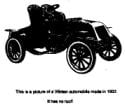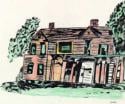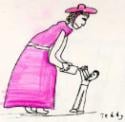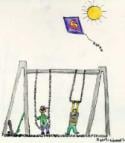School History
 |
Do
you ever wonder how Jackson Road Elementary School got its name? You
might think it was named after Michael Jackson, the popular singer, or
Andrew Jackson, who used to be the president of the United States. |
 |
Well,
it wasn't. It was named after T. Lamar Jackson and his wife, Elizabeth
B. Jackson. A long time ago, they owned a farm just down by the pond
near our school. In fact, they owned the pond and most of the land
around Jackson Road Elementary School.
To find out more about them and their life, read our book.
|
 |
T.
Lamar Jackson and his wife, Elizabeth B. Jackson, owned the land where
our school now stands. Mr. Jackson was a farmer who farmed 66 acres of
land around our school. He raised Aberdeen Angus cattle (which are BIG
black cows), and also grew crops using methods that were very productive
and modern for their time. |
 |
Mr.
Jackson also sold new cars. He sold touring automobiles that were in
style, including one called a Winton, which you probably haven't seen
because they're not made anymore. |
 |
When
Mr. Jackson was a young man, he got shipwrecked on the Canary Islands.
When he came back he named his farm Tenerife, which is also the name of
the largest of the Canary Islands. |
 |
Mrs.
Elizabeth B. Jackson lived on the farm in a beautiful white farmhouse
with her husband until he died in 1948. After Mr. Jackson died, Mrs.
Jackson kept the farm going with help from Nettie King, who did
household and garden chores, and a hired man, who did the farming and
cared for the cattle.
Mrs. Jackson had a small dog, Nippy, and some other large dogs. Chickens, ducks and other small animals also lived on the farm.
|
 |
Mrs.
Jackson gave money to charities and was very involved with the
Methodist Church. Although she and Mr. Jackson never had children, she
loved children and was very kind to them. Both Mr. and Mrs. Jackson were
very caring people.
Mrs. Jackson died in 1958. After Mr. and
Mrs. Jackson died, the farm was put to many different uses, according to
their wishes. Mrs. Jackson had wanted some of the farm to go to the
Methodist Church for a retirement home for the ministers. Some of the
land was turned into the houses you see around the school today. She
also wanted some land to be used for children. That land was turned into
Jackson Road Elementary School, White Oak Middle School and Martin
Luther King Recreation Center.
|
 |
If Mrs. Jackson were here now to see all this, she would be happy to see how her land is enjoyed by people of all ages.
Brian Phelps is a fourth grade student at
Jackson Road Elementary School. He lives down the street from the
Jackson farm, in the same house where his mother grew up. Mrs. Phelps
remembers one day when one of the Aberdeen Angus cattle escaped and
scared her so much that she cried and didn't want to leave the house. To
find out what happened next, read Brian's interview with Mrs. Phelps:
|
Interview
Brian: Do you remember the old Jackson farm house?

Linda Phelps: Yes, I do. In fact, I remember one morning when I was in Jr. high school I saw a cow on our front lawn. I think it came from the old Jackson farm.
Brian: How did you feel?
Linda Phelps: You'll never know how shocked I was. There I was on my way to school, I opened the door and this cow was on the front lawn. We had just moved from the city and even though I had seen plenty of cows in books, it's quite a difference seeing one chewing the grass on your front lawn!
Brian: What did you do?
Linda Phelps: I remember I closed the front door and called my mother at work. I think my mom thought I had gone nuts when I told her there was a cow on our front lawn. I was already late for school so I got up my courage and walked past the cow and ran to school.
Brian: Did you see any other animals escape from the farm?
Linda Phelps: The only other animal I can remember was a great sheep dog. Every once in a while he would get loose. He liked to jump on the children and even though he wasn't a mean dog, it still scared me.
Acknowledgments
We would like to thank Ernest R. Harmon, Mrs. Jackson's family physician, and Linda Phelps, who provided the information for this book. We would also like to thank Chris Doyle and Eleanor Brown, who helped us edit this book.










